OnePlus 10R vs OnePlus 9RT vs OnePlus 10 Pro performance comparison: is Dimensity 8100 better than Snapdragon 888 and 8 Gen 1 processors? | 91mobiles.com
MediaTek chipsets can be found on a truckload of affordable phones in India. However, Qualcomm still powers the lion’s share of the premium smartphones in the country, and more often than not, you’ll find a Snapdragon processor ticking inside a flagship or a flagship killer. Be that as it may, MediaTek wowed the audience and critics with the Dimensity 1200 platform, a high-end SoC that powered a slew of devices from popular brands like Xiaomi and Realme. And, in 2022, the company is upping the ante yet again with the Dimensity 8100 chipset. So much so, that both, OnePlus and Realme have already employed the processor in their latest performance-focussed handsets, namely the OnePlus 10R (review) and the Realme GT Neo 3 (review).
Understandably, a lot of buyers are curious about the chipset’s performance chops – in particular, how does the processor fare against the Snapdragon 888 and Snapdragon 8 Gen 1 mobile platforms. Well, that’s what I’m here to demystify so, without any further ado, let’s jump right in.
Benchmarks
Starting with the benchmarks, the MediaTek Dimensity 8100 SoC put on a good show and the chipset outputted higher multi-core numbers in GeekBench than both, the OnePlus 9RT (review) as well as the OnePlus 10 Pro (review). To wit, the device net 3,767 points, whereas the SD888-backed 9RT yielded 3,157 points only. Making matters even more interesting, Qualcomm’s top-of-the-line Snapdragon 8 Gen 1 platform outputted just 3,387 points as well. Now, bear in mind that the Dimensity 8100 SoC’s single-core scores were the lowest of the lot, with the processor netting just 957 points. Qualcomm’s Snapdragon 888 platform came in second at 1,120 points, with the Snapdragon 8 Gen 1 chipset leading the pack at 1,249 points.
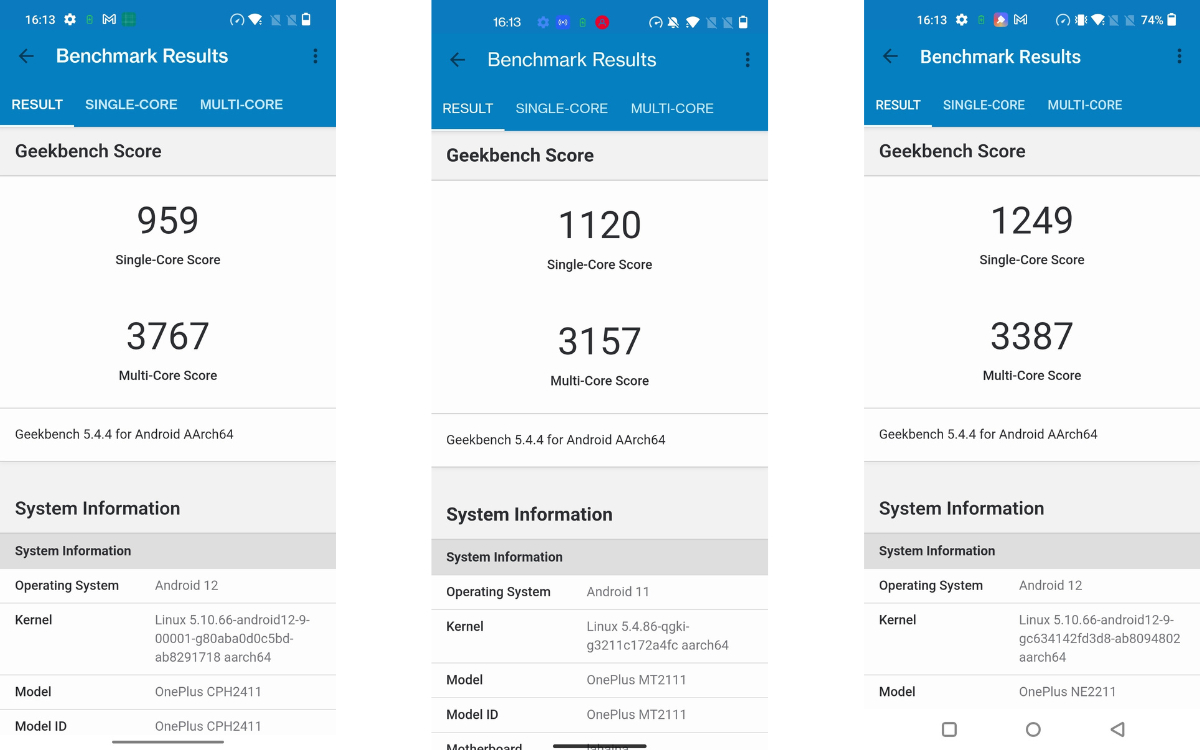
Now, for the uninitiated, GeekBench’s single-core score portrays a processor’s performance for single-threaded workloads like browsing the web, running games, etc. Do note that some of these tasks might incorporate multiple threads too, however, for the most part, the CPU rarely has to dispense the workload across different cores. Interestingly, the Dimensity 8100 SoC’s single-core score is on par with the SD888-backed OnePlus 9RT. Therefore, you can infer that both the chipsets are equally adept at tackling a single-threaded task. That said, the multi-core performance – which gauges a CPU’s prowess across parallel instruction streams – is significantly higher on the Dimensity 8100 platform.
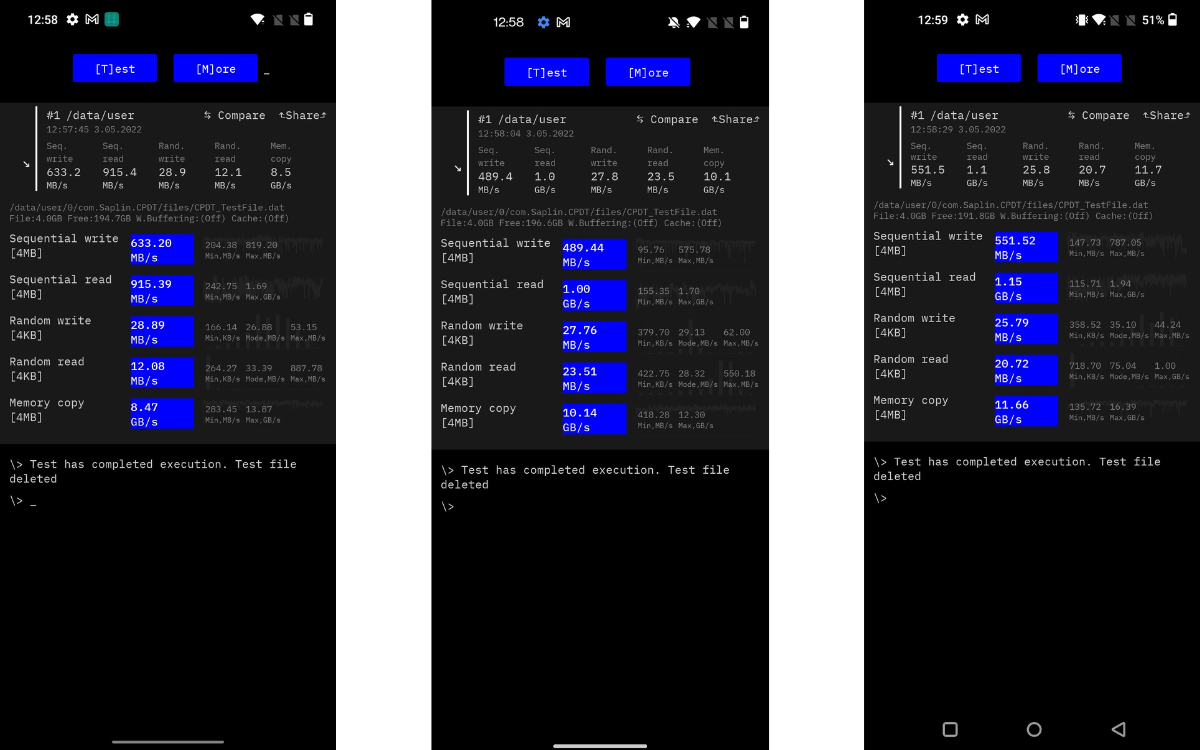
To be clear, you won’t immediately benefit from the Dimensity 8100 SoC’s multi-core scores. In fact, routine multi-threaded workloads like opening multiple tabs in Chrome, or using an app in split-screen rarely stress the CPU as much as a benchmarking utility. Be that as it may, it’s clear that MediaTek has closed the gap with its Qualcomm counterparts in terms of raw horsepower.
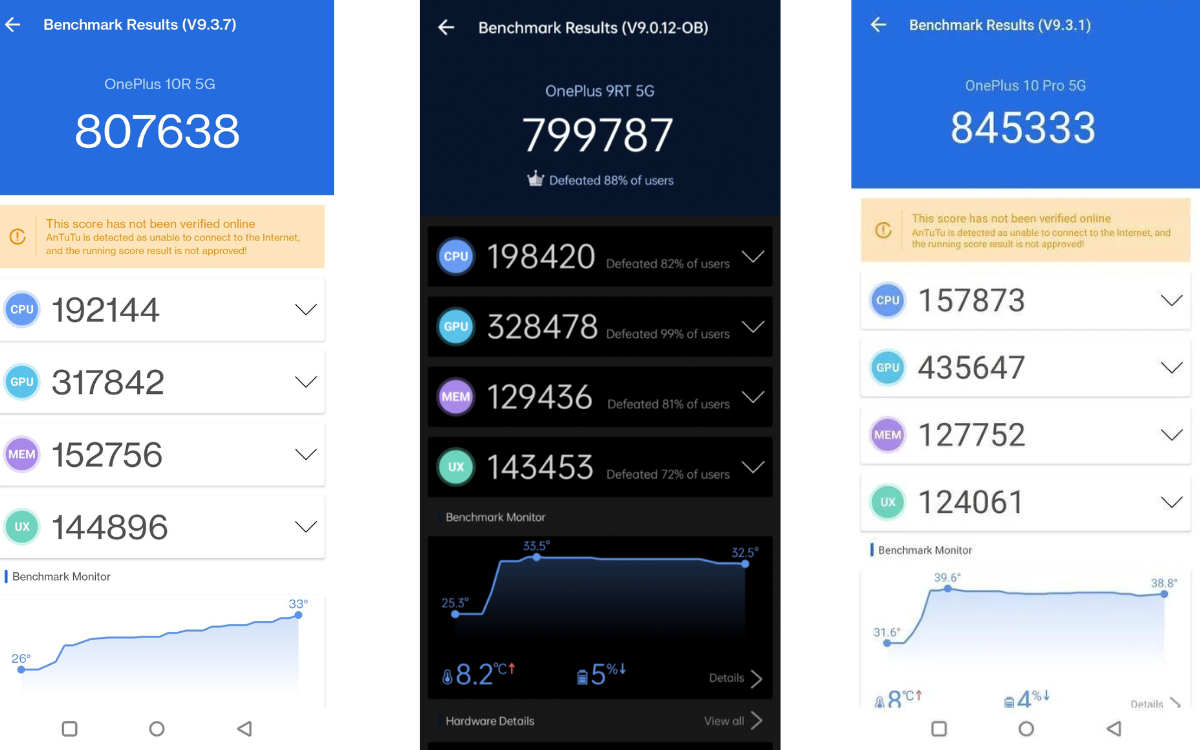
My findings were substantiated further in the Antutu benchmark wherein, the OnePlus 9RT yielded 7,99,787 points, the OnePlus 10R outputted 8,07,638 points and the OnePlus 10 Pro secured 8,45,333 points. I should also point out that all three SoCs employ speedy LPDDR5 memory and UFS 3.1 storage. I did run the cross-platform disk read and write test on the phones and to no one’s surprise, the trio outputted excellent sequential read and write speeds. You can refer to the image attached above for more insights but, for now, let’s take a closer look at the SoC’s performance under sustained loads.
Stability
It goes without saying that the faster a processor, the more heat it is likely to generate. If the heat isn’t dissipated adequately, then chances are that the CPU might throttle. More often than not, you’ll run into throttling issues whilst playing games on your phone for extended periods. That said, there are a couple of synthetic testing apps that can also give you a number on your CPU’s stability scores, chief among them being 3DMark, and the CPU throttle test.
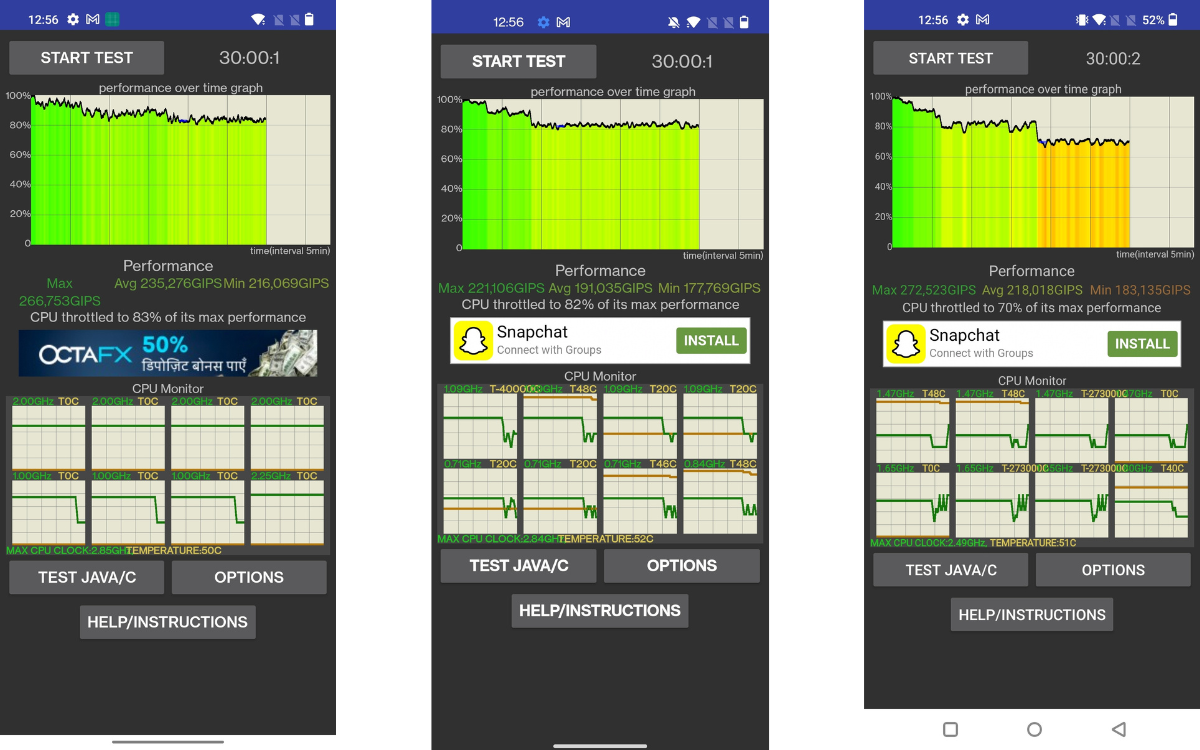
Let’s start with the CPU throttle test, which in a nutshell, overloads all the cores of a CPU with a sustained workload. Here, the Dimensity 8100 SoC outputted exemplary results, and the device throttled to just 83 percent of its peak performance. The SD888 chipset, on the other hand, out-turned a good score too and the SoC throttled to just 82 percent of its peak performance. Interestingly, the Dimensity 8100 SoC reported significantly higher peak and average instructions per second than the SD888 chipset and despite that, the SoC throttled less too. The Snapdragon 8 Gen 1 platform, on the other hand, yielded the highest instructions per second, albeit throttled the most at 70 percent of its maximum throughput.
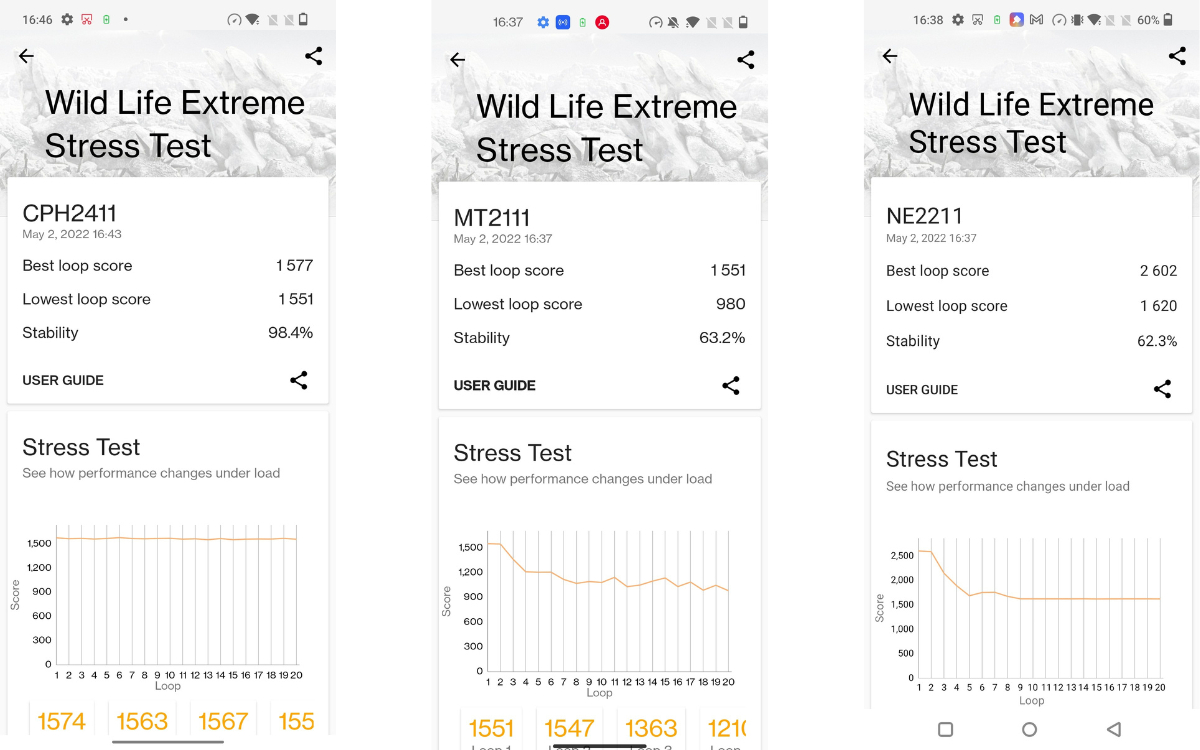
Turn the page over to 3DMark’s Extreme Stress test and you’ll find a similar result. For those unaware, the utility stresses a smartphone’s CPU and GPU by tasking the phone with twenty loops or runs of the benchmark, thereby giving users an indication of how the phone will perform over a longer stretch of time. Here, the Snapdragon 8 Gen 1 backed OnePlus 10 Pro exhibited the best loop score of 2,602 points. That said, the handset’s performance stability was nothing to write home about and the SoC maintained a 62.3 percent stability. The SD888-powered OnePlus 9RT, on the other hand, yielded 1,551 points in its best run and offered 63.2 percent stability. Finally, the Dimensity 8100 SoC outputted a ‘best loop’ score of 1,577 points and at the same time, the chipset offered the best performance stability at 98.4 percent. Suffice it to say, the Dimensity 8100 SoC isn’t just adept at crunching through a user’s workload, but it can sustain its peak performance for longer stints too.
Gaming
Unfortunately, the Dimensity 8100 SoC’s gaming performance is its Achilles’ heel. To wit, unlike Qualcomm’s Snapdragon 888 and 8 Gen 1 chipsets, the Dimensity 8100 SoC cannot run popular Android games at comparable graphics and FPS settings. For instance, BGMI, which runs at HDR and Extreme on both, the OnePlus 10 Pro as well as the OnePlus 9RT, caps out at just HD graphics and High FPS presets on the OnePlus 10R. In fact, the title even allows the 10 Pro and 9RT to utilise the 4K UHD texture pack, which betters the in-game graphics significantly. The same is true for CoD Mobile as well, which maxes out at Very High graphics and Very High FPS on the 10R. On the flip side, the game runs perfectly well with the graphics set to Very High and the FPS locked at Max on the 10 Pro as well as the 9RT.
So, what gives? Well, from what I could gather, the Dimensity 8100 SoC is in dire need of some optimisation that will help the processor scale its performance across different games adequately. I say this because the chipset can, in fact, run demanding games admirably. Case in point, Genshin Impact, which is among the most resource-hungry Android games, and much to my surprise, the title runs fine on the set. In fact, even with most of the settings maxed out (the shadows were set to low, and motion blur was turned off) and the game set to run at 60fps, the Dimensity 8100 SoC yielded stellar results. While I did net lesser average FPS compared to the Snapdragon 888 and 8 Gen 1 chipsets, the Dimensity 8100 SoC offered lesser janks too, meaning the game stuttered less, which was evident when I was switching characters in the heat of a battle. The animation appeared abrupt on the OnePlus 9RT, albeit felt less jarring on the 10R and the 10 Pro.
Furthermore, unlike Qualcomm’s offerings, the Dimensity 8100 SoC ran significantly cooler too. All things considered, my gaming experience was on par, if not better on the OnePlus 10R than the OnePlus 9RT. That said, the OnePlus 10 Pro is still the king of the hill, and buyers looking to invest in a premium gaming phone will find plenty to like about the device.
Verdict
To say that MediaTek came out swinging in 2022 would be a bit of an understatement. In fact, the Dimensity 8100 SoC is a fantastic chipset that will impress buyers who value their smartphone’s performance immensely. For one, the processor’s computing prowess is at a level pegging with Qualcomm’s high-end offerings. The icing on the cake is that the chipset’s stability scores were off the charts, and the unit handles temps relatively better too. That said, hardcore gamers will still be better off with a phone backed by a Snapdragon SoC, simply because the chipset can render modern Android games at better graphics and FPS settings. I do hope MediaTek and partner brands fix the Dimensity 8100’s gaming woes as it is the only bad cog in an otherwise well-oiled machine. Do let me know in the comments below as to which chipset impressed you the most and as always, stay glued to our blog for more comparisons.
For all the latest Technology News Click Here
For the latest news and updates, follow us on Google News.
